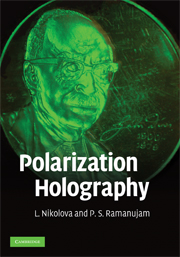Book contents
- Frontmatter
- Contents
- Preface
- List of symbols and abbreviations
- 1 Light polarization
- 2 Light propagation through polarizing systems
- 3 Theory of polarization holography
- 4 Azobenzene and azobenzene-containing polymers
- 5 Other photoanisotropic materials
- 6 Applications of polarization holography
- 7 Conclusions and future prospects
- Index
- Plate section
5 - Other photoanisotropic materials
Published online by Cambridge University Press: 07 August 2009
- Frontmatter
- Contents
- Preface
- List of symbols and abbreviations
- 1 Light polarization
- 2 Light propagation through polarizing systems
- 3 Theory of polarization holography
- 4 Azobenzene and azobenzene-containing polymers
- 5 Other photoanisotropic materials
- 6 Applications of polarization holography
- 7 Conclusions and future prospects
- Index
- Plate section
Summary
Photoinduced anisotropy in silver-halide materials
The appearance of dichroism in silver-halide emulsions exposed to linearly polarized light was first observed by F. Weigert [1–3] in 1919. This effect is called the Weigert effect (W-effect). Weigert discovered that the effect was most pronounced if the emulsion layer was first exposed to unpolarized short-wavelength light to form print-out silver and afterwards to long-wavelength linearly polarized light. Photodichroism was observed in layers only before photographical development. Later it was found that the effect could be reversible [4]. When a silver chloride (AgCl) emulsion layer was exposed to polarized red light and then the polarization direction was rotated by 90°, the degree of dichroism first diminished, then disappeared completely, and, with continued exposure, reappeared with opposite sign with respect to the first time. This reversible effect could be achieved several times by rotating the polarization direction. Photoinduced dichroism was later observed also in single crystals of AgCl. Hilsch and Pohl [5] and Cameron and Taylor [6] found that, when AgCl crystals are exposed first to unpolarized UV light and then to linearly polarized red light, they become dichroic. The effect was also observed by Zocher and Coper [7].
All these early investigators of the W-effect tried also to give a theoretical explanation. They all assumed that the first exposure created anisotropic particles distributed in all directions.
- Type
- Chapter
- Information
- Polarization Holography , pp. 141 - 173Publisher: Cambridge University PressPrint publication year: 2009



